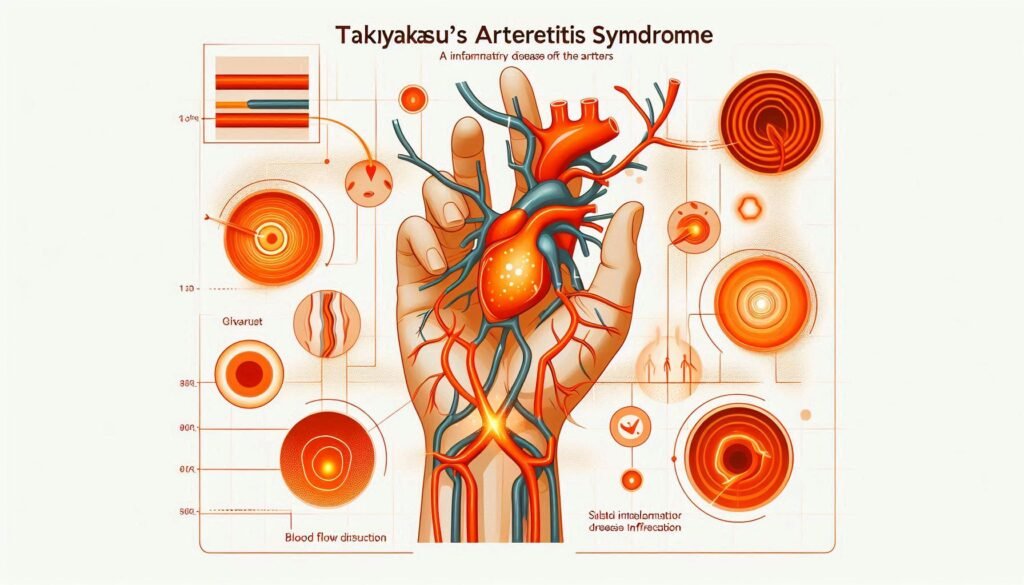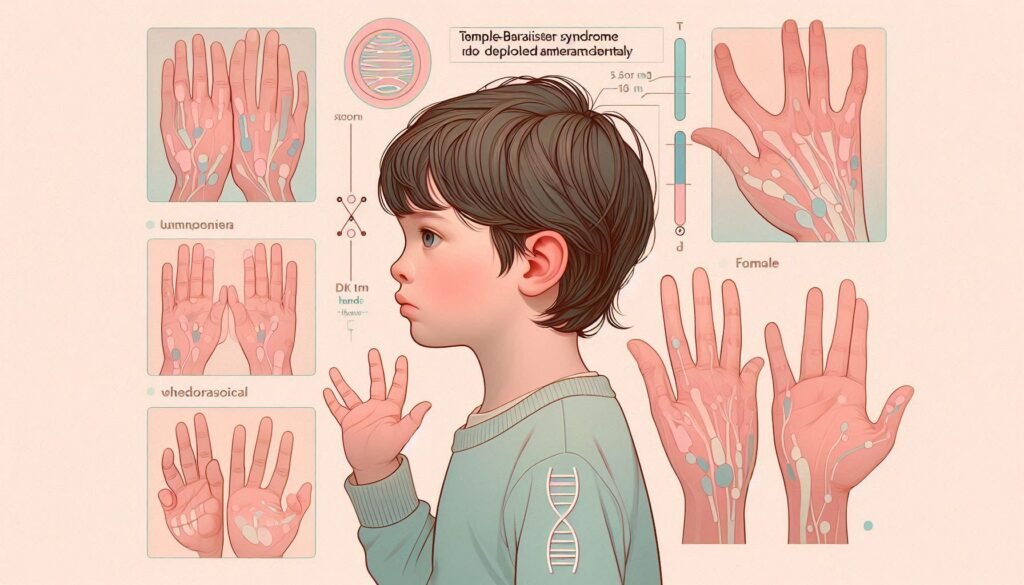Takayasu’s Arteritis Syndrome is a rare but serious vascular disease that often flies under the radar. Named after Japanese physician Mikito Takayasu, who first described it in 1908, this condition primarily affects young women and can lead to severe complications if not diagnosed and treated promptly. The syndrome involves inflammation of large blood vessels, particularly the aorta and its major branches, which can disrupt blood flow throughout the body.
As awareness grows about this elusive disease, it’s essential to understand its complexities — from symptoms that mimic other conditions to advanced imaging techniques needed for diagnosis. This comprehensive guide delves into every aspect of Takayasu’s Arteritis Syndrome. Whether you’re looking for information due to personal experience or simply want to expand your medical knowledge, you’ll find valuable insights here. Join us on this journey as we explore what makes Takayasu’s Arteritis so unique and significant in today’s medical landscape.

Understanding Takayasu’s Arteritis: Definition and Overview
Takayasu’s Arteritis Syndrome is an autoimmune condition characterized by inflammation of the large blood vessels. This primarily includes the aorta and its main branches, which are crucial for delivering oxygen-rich blood throughout the body.
The disorder typically manifests in young adults, especially women under 40. Symptoms often arise insidiously and can include fatigue, weight loss, fever, and night sweats. These vague signs can make early diagnosis challenging.
“Why Does Burning Mouth Syndrome Occur? Treatment Guide”
As a form of large vessel vasculitis, Takayasu’s Arteritis can lead to serious complications such as organ ischemia due to narrowed arteries or even aneurysms. Awareness of this rare disease plays a vital role in improving outcomes through timely intervention. Understanding its definition sets the stage for recognizing symptoms and seeking appropriate care when needed.
Historical Perspective: From Mikito Takayasu to Modern Understanding
Takayasu’s Arteritis is named after Dr. Mikito Takayasu, a Japanese ophthalmologist who first described the condition in 1908. His observations focused on patients showing symptoms of vascular abnormalities and severe ocular changes.
Initially, it was thought to be a rare disease limited to Asia. However, as research expanded globally, clinicians began recognizing its presence across various populations.
“What Is Bálint’s Syndrome? Understanding Visual Processing Issues”
Over the decades, advances in medical imaging and immunology have transformed our understanding of this syndrome. Researchers now know that it primarily affects young women and can lead to significant morbidity if left untreated.
Modern studies emphasize the autoimmune nature of Takayasu’s Arteritis while unraveling genetic factors contributing to its onset. This evolving knowledge has paved the way for improved diagnostic criteria and treatment strategies tailored specifically for affected individuals around the world.
Epidemiology of Takayasu’s Arteritis: Prevalence and Demographic Patterns
Takayasu’s Arteritis is a rare vascular condition, primarily affecting young women. Its prevalence varies significantly across regions, with higher rates reported in Asian countries compared to Western populations.
“How Does CADASIL Syndrome Affect Brain Blood Vessels?”
The disease typically manifests in individuals aged 10 to 40 years. This demographic pattern highlights the importance of early diagnosis and intervention for better outcomes.
Genetic predispositions may play a role, as certain ethnic groups exhibit increased vulnerability. For instance, South Asian and East Asian populations have notably higher incidence rates.
Environmental factors could also contribute to the disease’s epidemiology. Exposure to specific infections or pollutants might trigger its onset among genetically susceptible individuals.
Understanding these patterns aids healthcare providers in recognizing Takayasu’s Arteritis sooner and tailoring preventive strategies accordingly. Awareness of its unique demographics can enhance research efforts aimed at unraveling this complex syndrome further.
Etiology: Exploring the Causes of Takayasu’s Arteritis
The exact cause of Takayasu’s Arteritis Syndrome remains elusive. However, it is believed to be an autoimmune disorder where the body’s immune system mistakenly attacks its own blood vessels.
“What Causes Cat Eye Syndrome? Chromosome 22 Guide”
Genetic factors may play a significant role in predisposing individuals to this condition. Certain human leukocyte antigen (HLA) types have been linked to higher risks of developing the disease, particularly in specific ethnic groups.
Environmental triggers also warrant consideration. Viral infections and exposure to toxins could potentially initiate or exacerbate inflammatory processes within blood vessels.
Additionally, hormonal influences are being studied due to the syndrome’s higher prevalence among women, especially during reproductive years. Understanding these underlying causes is crucial for developing targeted therapies and improving patient outcomes over time.
Pathophysiology: How Takayasu’s Arteritis Affects Blood Vessels
Takayasu’s Arteritis Syndrome primarily affects large blood vessels, particularly the aorta and its major branches. This autoimmune condition leads to inflammation of the arterial walls. The immune system mistakenly targets these vessels, causing damage.
“How Does Charcot-Marie-Tooth Disease Affect Nerves?”
Inflammation results in thickening and narrowing of blood vessels. As a consequence, blood flow is restricted. Organs may not receive adequate oxygen and nutrients, leading to various complications.
The inflammatory process can also result in aneurysms or vessel occlusions over time. These changes create significant risks for ischemia—where tissues are deprived of oxygen—and can have severe consequences on overall health.
Understanding this intricate pathophysiology helps healthcare providers manage symptoms effectively while monitoring for potential complications associated with Takayasu’s Arteritis Syndrome.
Clinical Manifestations: Recognizing the Signs and Symptoms
Takayasu’s Arteritis Syndrome presents a range of clinical manifestations that can vary widely among individuals. Early symptoms often include fatigue, fever, and weight loss. These non-specific signs may initially be mistaken for other conditions.
“Why Does Chronic Fatigue Syndrome Cause Persistent Tiredness?”
As the disease progresses, patients may experience more pronounced symptoms related to vascular involvement. This can manifest as limb claudication—pain in the arms or legs during physical activity due to reduced blood flow.
Patients might also report headaches or visual disturbances stemming from compromised blood supply to the head and neck arteries. Additionally, systemic symptoms like night sweats and joint pain are common.
In severe cases, hypertension could develop due to narrowed arteries leading to increased cardiovascular strain. Recognizing these diverse signs is crucial for timely diagnosis and management of Takayasu’s Arteritis Syndrome. Awareness is key in addressing this rare but serious condition effectively.
Stages of Takayasu’s Arteritis: From Early to Late Disease
Takayasu’s Arteritis progresses through distinct stages, each with its own characteristics.
Early disease typically presents with nonspecific symptoms like fatigue, fever, and weight loss. These signs can be easily overlooked or mistaken for other illnesses.
As the condition advances, vascular symptoms emerge. Patients may experience limb pain due to reduced blood flow or develop high blood pressure from narrowed arteries.
In later stages, complications become more pronounced. Significant arterial damage can lead to ischemia in organs and tissues. This stage often requires urgent medical attention due to severe consequences.
Monitoring these phases is crucial for effective management. Early detection of changes in clinical presentation helps tailor treatment strategies effectively and improve patient outcomes over time. Understanding this progression allows healthcare providers to offer timely interventions that could mitigate long-term effects on health.
Diagnostic Criteria: The American College of Rheumatology Guidelines
The American College of Rheumatology (ACR) has established specific criteria for diagnosing Takayasu’s Arteritis Syndrome. These guidelines help clinicians identify this rare condition accurately and promptly.
Diagnosis typically involves a combination of clinical features and imaging findings. A patient may meet the criteria if they exhibit symptoms such as arm or chest pain, decreased blood pressure in one arm, or reduced pulse strength.
Imaging studies play a crucial role. Angiography is often employed to reveal vascular irregularities characteristic of the disease. Other techniques like MRI and CT scans can also provide valuable insights into arterial inflammation.
Additionally, laboratory tests are considered to assess inflammatory markers. Elevated erythrocyte sedimentation rate (ESR) or C-reactive protein (CRP) levels can support the diagnosis but aren’t definitive on their own.
Collectively, these guidelines enhance diagnostic accuracy and ensure timely treatment interventions for those affected by this complex syndrome.
Imaging Techniques: Angiography, CT, MRI, and PET in Diagnosis
Imaging techniques play a crucial role in diagnosing Takayasu’s Arteritis Syndrome. These methods help visualize the blood vessels affected by this rare vascular disease.
Angiography is often the first choice. It uses X-rays to obtain detailed images of blood vessels, revealing blockages or abnormalities. This technique provides clear insights into arterial involvement.
CT scans are also beneficial. They offer cross-sectional images that can show vessel wall thickening and stenosis, which are hallmarks of the disease.
MRI stands out for its ability to assess both soft tissue and vascular structures without radiation exposure. This method excels in evaluating inflammation around arteries.
PET scans provide functional information about metabolic activity in tissues. They can be particularly useful for assessing inflammatory activity within the affected vessels. Each imaging modality contributes valuable data for an accurate diagnosis and effective treatment planning.
Laboratory Tests: Blood Work and Inflammatory Markers
Laboratory tests play a crucial role in diagnosing Takayasu’s Arteritis Syndrome. Blood work helps assess inflammation levels and overall health.
Inflammatory markers such as C-reactive protein (CRP) and erythrocyte sedimentation rate (ESR) are commonly measured. Elevated levels of these markers indicate an ongoing inflammatory process, which is characteristic of this vascular disease.
Additionally, complete blood counts can reveal anemia or thrombocytosis, both common findings in patients with Takayasu’s. These abnormalities often suggest that the body is responding to chronic inflammation.
Autoantibody tests may also be performed to rule out other autoimmune conditions. While no specific test confirms Takayasu’s Arteritis, these laboratory evaluations provide valuable insights into its presence and severity. Monitoring these markers over time assists healthcare providers in managing treatment effectively.
Differential Diagnosis: Distinguishing from Other Vasculitis Syndromes
Differential diagnosis for Takayasu’s Arteritis Syndrome is crucial due to overlapping symptoms with other vasculitis syndromes. These conditions may include Giant Cell Arteritis, Behçet’s Disease, and Polyarteritis Nodosa.
Giant Cell Arteritis primarily affects older adults and usually presents with temporal headaches and jaw claudication. In contrast, Takayasu’s often targets younger women of Asian descent.
Behçet’s Disease features oral and genital ulcers alongside systemic inflammation, which can sometimes mimic the systemic manifestations seen in Takayasu’s.
Polyarteritis Nodosa typically involves medium-sized vessels affecting various organs but lacks the prominent aortic involvement characteristic of Takayasu’s.
A thorough clinical evaluation combined with targeted imaging studies is essential in distinguishing these syndromes from each other. Accurate diagnosis will guide effective treatment strategies tailored to each patient’s unique presentation.
Treatment Strategies: Medical Management of Takayasu’s Arteritis
Medical management of Takayasu’s Arteritis Syndrome primarily focuses on controlling inflammation and preventing complications. Corticosteroids, like prednisone, are often the first line of treatment. They help reduce inflammation quickly and alleviate symptoms.
Immunosuppressive agents may be introduced for long-term management. Medications such as methotrexate or azathioprine can help maintain remission and minimize steroid use.
In some cases, biologics like tocilizumab have shown promise in treating severe manifestations of the disease. These targeted therapies aim to modulate the immune response more precisely.
Regular monitoring is essential during treatment to assess disease activity and adjust medications accordingly. Collaboration with rheumatologists ensures a tailored approach based on individual patient needs.
Lifestyle changes also play a role in managing Takayasu’s arteritis effectively. A balanced diet, regular exercise, and stress reduction techniques support overall well-being while undergoing treatment.
Surgical Interventions: When and How Surgery is Considered
Surgical interventions for Takayasu’s Arteritis Syndrome are considered in specific circumstances. When medical management fails to control symptoms or prevent complications, surgery may be necessary.
Indications for surgical treatment often include severe vascular stenosis or occlusion that leads to significant ischemia. Patients experiencing critical blood flow reduction might benefit from procedures aimed at restoring circulation.
Common surgical options involve bypass grafting and endarterectomy. Bypass grafts can redirect blood around blocked arteries, while endarterectomy removes plaque buildup directly from the artery walls.
Surgeons typically assess factors like patient age, overall health, and disease stage before recommending an operation. Timing is crucial; too early may expose patients to unnecessary risks, while delays can worsen outcomes.
Post-surgery monitoring is essential to evaluate the success of the intervention and manage any potential complications effectively. Regular follow-ups ensure that strategies remain aligned with evolving health needs.
Monitoring Disease Activity: Tools and Techniques
Monitoring disease activity in Takayasu’s Arteritis Syndrome is crucial for managing the condition effectively. Regular assessments help track inflammation and guide treatment decisions.
One common tool used is the Disease Activity Score, which incorporates clinical symptoms and laboratory results. This score provides healthcare professionals with a clear picture of disease progression or remission.
Imaging techniques also play a pivotal role in monitoring. Ultrasound can visualize blood flow changes, while MRI offers detailed views of vascular involvement. These methods can detect abnormalities before they lead to serious complications.
Blood tests are essential as well. Monitoring inflammatory markers like C-reactive protein (CRP) helps gauge ongoing inflammation levels. Additionally, regular evaluations of kidney function and blood pressure are vital, given their importance in assessing overall health during treatment.
Patient-reported outcomes are another valuable resource. Keeping diaries detailing symptoms can enhance communication between patients and healthcare providers about any fluctuations in their condition.
Complications: Potential Long-term Effects of Takayasu’s Arteritis
Takayasu’s Arteritis can lead to significant long-term complications affecting various organ systems. One of the primary concerns is cardiovascular health. The inflammation and narrowing of blood vessels can result in hypertension, ischemic heart disease, or even strokes.
Kidney function may also be compromised due to reduced blood flow or renal artery involvement. This impairment might necessitate dialysis in severe cases.
Vision problems are another potential consequence. If the arteries supplying the eyes become affected, patients may experience vision loss or blindness.
Additionally, chronic pain and fatigue are common among those living with this condition. These symptoms can significantly impact a person’s quality of life over time.
Psychological effects should not be overlooked either; anxiety and depression often arise from coping with a chronic illness like Takayasu’s Arteritis. Each complication highlights the importance of regular monitoring and comprehensive care strategies for affected individuals.
Pregnancy and Takayasu’s Arteritis: Special Considerations
Pregnancy poses unique challenges for women with Takayasu’s Arteritis Syndrome. Hormonal changes and increased blood volume can exacerbate symptoms, necessitating careful monitoring throughout gestation.
Managing the condition during pregnancy typically involves a multidisciplinary approach. Rheumatologists, obstetricians, and maternal-fetal medicine specialists collaborate to ensure both mother and baby remain healthy.
Medications used to treat Takayasu’s Arteritis may need adjustment during pregnancy. Some drugs are contraindicated due to potential risks to fetal development. Regular assessments help balance disease control with safety for the developing child.
Women should be vigilant about any new symptoms or flare-ups during this time. Early intervention is crucial in mitigating complications related to vascular inflammation.
Postpartum care also requires attention since hormonal shifts can influence disease activity. Ongoing support is essential as mothers navigate their health alongside caring for a newborn.
Living with Takayasu’s Arteritis: Lifestyle Adaptations and Self-Care
Living with Takayasu’s Arteritis requires thoughtful lifestyle adaptations to manage symptoms and improve quality of life. Maintaining a balanced diet rich in anti-inflammatory foods can be beneficial. Incorporating fruits, vegetables, whole grains, and lean proteins helps support overall health.
Regular exercise is vital but should be approached cautiously. Low-impact activities like walking, swimming, or yoga can enhance cardiovascular fitness without straining the body too much. Always consult your healthcare provider before starting any new exercise regimen.
Stress management plays an important role as well. Techniques such as meditation, deep breathing exercises, or mindfulness practices can help alleviate stress levels and promote mental well-being.
Staying informed about the condition empowers patients in managing their health effectively. Joining support groups connects individuals facing similar challenges and provides emotional encouragement throughout their journey with Takayasu’s Arteritis Syndrome.
Pediatric Takayasu’s Arteritis: Unique Aspects in Children
Pediatric Takayasu’s Arteritis presents distinct challenges compared to adult cases. Children often experience rapid disease progression, which can lead to significant complications if not diagnosed early.
Symptoms may differ in younger patients. Fatigue, fever, and limb pain are common initial complaints that can easily be mistaken for other conditions. Parents should remain vigilant for signs of abnormal blood pressure or diminished pulses in the arms and legs.
Diagnosis is also more complex in children due to the rarity of this condition within this age group. Pediatricians must rely on a mix of clinical evaluation and advanced imaging techniques to confirm suspicions of Takayasu’s Arteritis.
Treatment protocols typically involve corticosteroids and immunosuppressants tailored specifically for growing bodies. Close monitoring is crucial, as medication side effects can impact growth and development over time.
Education about the disease empowers families dealing with pediatric Takayasu’s Arteritis, fostering better management strategies at home.
Research Frontiers: Current Studies and Future Directions
Research on Takayasu’s Arteritis Syndrome is rapidly evolving, shedding light on this complex condition. Current studies are focusing on identifying genetic predispositions and biomarkers that could aid early diagnosis. Researchers are also investigating the role of environmental factors in triggering inflammation.
Clinical trials are underway to evaluate new treatments aimed at reducing disease activity and improving patients’ quality of life. These include biological agents targeting specific pathways involved in vasculitis. The goal is to find therapies that provide more effective relief with fewer side effects compared to traditional immunosuppressants.
There’s a growing emphasis on understanding the long-term impacts of Takayasu’s Arteritis. Investigating how it affects cardiovascular health over time remains crucial for developing comprehensive management strategies.
Innovative imaging techniques continue to advance, allowing for earlier detection and monitoring of vascular changes associated with the disease. This not only enhances our understanding but also improves patient care through personalized treatment approaches.
As researchers collaborate globally, there’s hope for breakthroughs that will transform how we view and treat Takayasu’s Arteritis Syndrome in the future. The focus remains not just on managing symptoms but also addressing root causes to improve outcomes significantly for those affected by this rare vascular disease.


